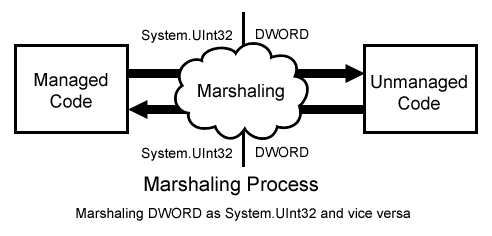Read the Full book here
What is Marshaling?
Marshaling is the process of creating a bridge between managed code and unmanaged code; it is the homer that carries messages from the managed to the unmanaged environment and reverse. It is one of the core services offered by the CLR (Common Language Runtime.)
Because much of the types in unmanaged environment do not have counterparts in managed environment, you need to create conversion routines that convert the managed types into unmanaged and vice versa; and that is the marshaling process.
As a refresher, we call .NET code "managed" because it is controlled (managed) by the CLR. Other code that is not controlled by the CLR is called unmanaged.
Why Marshaling?
You already know that there is no such compatibility between managed and unmanaged environments. In other words, .NET does not contain such the types HRESULT, DWORD, and HANDLE that exist in the realm of unmanaged code. Therefore, you need to find a .NET substitute or create your own if needed. That is what called marshaling.
An example is the unmanaged DWORD; it is an unsigned 32-bit integer, so we can marshal it in .NET as System.UInt32. Therefore, System.UInt32 is a substitute for the unmanaged DWORD. On the other hand, unmanaged compound types (structures, unions, etc.) do not have counterparts or substitutes in the managed environment. Thus, you'll need to create your own managed types (structures/classes) that will serve as the substitutes for the unmanaged types you use.
When I Need to Marshal?
Marshaling comes handy when you are working with unmanaged code, whether you are working with Windows API or COM components. It helps you interoperating (i.e. working) correctly with these environments by providing a way to share data between the two environments. Figure 1 shows the marshaling process, where it fall, and how it is required in the communication process between the two environments.
